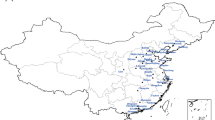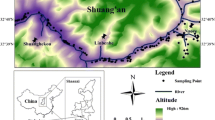Abstract
The selenium (Se) content of the diet and/or selenium supplements might have an ameliorating effect on arsenic (As) toxicity as recently shown by Wang et al. (1), Yang et al. (2), and as reviewed by Spallholz et al. (3). The underlying principles of the ameliorating effect is the complexation of Se with As forming the seleno-bis (S-glutathionyl) arsinium ion (4) excreted in bile and the complexation of Se with As in tissues forming nontoxic insoluble selenides (5,6). Addition protection afforded by Se supplementation from arsenicosis could be the elevation of glutathione peroxidase activity reducing the oxidative stress induced by As (7,8). The present study assessed the status of Se and As in hair by neutron activation analysis (NAA). Human hair samples were collected from the United States, Canada, The People's Republic of China (PRC), Bangladesh, and Nepal, the latter two countries now engaged in a struggle to find relief from human arsenicosis resulting from extensive domestic groundwater contamination by As. No statistically significant differences were observed in the samples between the Se and As content of hair from, Lubbock, Texas (USA) or Winnipeg, Canada. The concentration of As in all hair samples analyzed correlated (r=0.960, p<0.001) with the amount of As in the drinking water. Selenium levels in hair were highest from Nepal. The results demonstrate the viability of hair as a noninvasive biomonitor in assessing aspects of dietary Se and environmental As exposure. The hair data confirmed the known low intake of Se in the Keshan disease area of the PRC, the very high accumulation in hair of As from subjects consuming contaminated ground waters, and an adequate Se status in subjects from North America consuming municipal water of low As content. The high As content of hair from people in Bangladesh is the result of a high As consumption from contaminated water compounded by a less than desirable intake of Se (9). From Nepal, the As content of hair corresponded to the known low and high intake of As from contaminated groundwater. The very high Se content found in all hair samples from Nepal might be the result of the use of henna.
Similar content being viewed by others
References
W. Wang, L. Yang, H. Shaofan, et al., Prevention of endemic arsenism with selenium, Curr. Sci. 81, 1215–1218 (2001).
L. Yang, W. Wang, S. Hou, et al., Effects of selenium supplementation on arsenism: an intervention trial in inner mongolia, Environ. Geochem. Health 24, 359–374 (2002).
J. E. Spallholz, L. M. Boylan, V. Palace, et al., Environmental hypothesis: is poor dietary selenium intake an underlying factor for arsenicosis and cancer in Bangladesh and West Bengal, India? Sci. Total Environ. 323, 21–32 (2004).
J. Gailer, G. N. George, I. J. Pickering, et al., A metabolic link between arsenite and selenite: the seleno-bis(S-glutathionyl) arsinium ion, J. Am. Chem. Soc. 122, 4637–4639 (2000).
E. Glattre, A. Mravcova, J. Lener, et al., Study of distribution of interaction of arsenic and selenium in rat thyroid, Biol. Trace Element Res. 49, 177–186 (1995).
Z. Gregus, A. Gyurasics, and I. Csanaky, Effects of arsenic-, platinum-, and gold-containing drugs on the disposition of exogenous selenium in rats, Toxicol. Sci. 57, 22–31 (2000).
J. Rotruck, A. L. Pope, H. E. Ganther, et al., Selenium: biochemical role as a component of glutathione peroxidase, Science 179, 588–590 (1973).
T. S. Wang, Y. F. Shu, Y. C. Liu, et al., Glutathione peroxidase and catalase modulate the genotoxicity of arsenic, Toxicology 121, 229–237 (1997).
S. H. Frisbe, R. Ortega, D. M. Maynard, and B. Sarkar, The concentrations of arsenic and other toxic elements in bangladesh's drinking water, Environ. Health Perspect. 110, 1147–1153 (2002).
D. K. Harkins and A. S. Susten, Hair analysis: exploring the state of the science, Environ. Health Perspect. 111, 187–193 (2003).
Y. Shiobara, T. Yoshida, and K. T. Suzuki, Effects of dietary selenium species on Se concentrations in hair, blood, and urine, Toxicol. Appl. Pharmacol. 152, 309–314 (1998).
J. E. Spallholz and J. L. Martin, Tissue retention of 75selenium by mice fed diets supplemented with sodium selenite, selenocystine and selenomethionine, Fed. Proc. 36, 1152 (1977).
T. S. Srikumar, G. K. Johansson, P. A. Ockerman, et al., Trace element status in healthy subjects switching from a mixed to a lactovegetarian diet for 12 months, Am. J. Clin. Nutr. 55, 885–890 (1992).
E. J. Roekens, H. J. Robberecht, and H. A. Deelstra, Dietary selenium intake in belgium for different population groups at risk for deficiency, Z. Lebensm. Unters Forsch. 182, 8–13 (1986).
A. LeBlanc, P. Dumas, and L. Lefebvre, Trace element content of commercial shampoos: impact on trace element content in hair, Sci. Total Environ. 229, 121–124 (1999).
L. H. Lin, Y. L. Huang, and M. Y. Wang, Arsenic species in drinking water, hair, fingernails, and urine of patients with blackfoot disease, J. Toxicol. Environ. Health 53, 85–93 (1997).
A. Pazirandeh, A. H. Brati, and M. G. Marageh, Determination of arsenic in hair using neutron activation, Appl. Radiat. Isot. 49, 753–759 (1998).
P. Kurttio, H. Komulainen, E. Hakala, et al., Urinary excretion of arsenic species after exposure to arsenic present in drinking water, Arch. Environ. Contam. Toxicol. 34, 297–305 (1998).
M. M. Rahman, B. K. Mandal, T. R. Chowdhury, et al., Arsenic groundwater contamination and sufferings of people in north 24-parganas, one of the nine arsenic affected districts of West Bengal, India, J. Environ. Sci. Health A: Tox. Hazard Subst. Environ. Eng. 38, 25–59 (2003).
Y. S. Ryabukhin, Report No. IAEA/RL/50, International Atomic Energy Agency. Vienna, (1978).
National Academy of Science, Dietary Reference Intakes for Vitamin C, Vitamin E, Selenium, and Carotenoids, National Academy Press, Washington, DC, (2000).
J. E. Spallholz and L. M. Boylan, Assessment of the rural adult selenium intake from a typical Bangladeshi diet, (2004), unpublished.
Y. Xia, J. Piao, K. E. Hill, et al., Keshan disease and selenium status of populations in china, in Selenium in Biology and Human Health, R. F. Burk, ed., Springer-Verlag, New York, pp. 181–196 (1994).
U. K. Chowdhury, B. K. Biswas, T. R. Chowdhury, et al., Groundwater arsenic contamination in bangladesh and west bengal, india, Environ. Health Perspect. 108, 393–397 (2000).
J. E. Oldfield, Selenium World Atlas, Selenium-Tellurium Development Association, Grimbergen, Belgium, (1999).
B. F. Zhou, J. Stamler, B. Dennis, et al., Nutrient intakes of middle-aged men and women in China, Japan, United Kingdom, and United States in the late 1990s: The Intermap Study, J. Hum. Hypertens. 17, 623–630 (2003).
Y. Ohta, A. Nakano, and M. Matsumoto, Concentration of trace elements in hair from children living in a keshan disease district in china, Nihon Eisei Gakkai 47, 811–817 (1992).
H. M. Anawar, J. Akai, K. M. Mostofa, et al., Arsenic poisoning in groundwater: health risk and geochemical sources in bangladesh, Environ. Int. 27, 597–604 (2002).
K. R. Adamsen and A. Pokhrel, The arsenic content of drinking water in Nepal. Available from http://www.msnepal.org/reports_pubs/arsenic/report_arsenic.doc (accessed 2002).
R. R. Shrestha, M. P. Shrestha, N. P. Upadhyay, et al., Groundwater arsenic contamination, its health impact and mitigation program in Nepal, J. Environ. Sci. Health A: Tox. Hazard Subst. Environ. 38, 185–200 (2003).
O. A. Levander, Metabolic interrelationships between arsenic and selenium, Environ. Health Perspect. 19, 159–164 (1977).
O. A. Levander and C. A. Baumann, Selenium metabolism VI. Effect of arsenic on the excretion of selenium in bile, Toxicol. Appl. Pharmacol. 9, 106–115 (1966).
A. M. Hilmy, N. A. el-Domiaty, M. A. Kamal, et al., Effect of some arsenic antagonists on the toxicity, distribution and excretion of arsenite and arsenate in rats, Comp. Biochem. Physiol. 99, 357–362 (1991).
E. M. Kenyon, M. F. Hughes, and O. A. Levander, Influence of dietary selenium on the disposition of arsenate in the female B6C3F1 mouse, J. Toxicol. Environ. Health 51, 279–299 (1997).
H. S. Dang, D. D. Jaiswal, and S. Somasundaram, Distribution of arsenic in human tissues and milk, Sci. Total Environ. 29, 171–175 (1983).
A. K. Srivastava, S. K. Hasan, and R. C. Srivastava, Arsenicism in India: dermal lesions and hair levels, Arch. Environ. Health 56, 562 (2001).
A. K. Srivastava, S. K. Hasan, and R. C. Srivastava, Arsenicism in india: dermal lesions and hair levels, Environ. Int. 27, 597–604 (2002).
B. K. Mandal, Y. Ogra, and K. T. Suzuki, Speciation of arsenic in human nail and hair from arsenic-affected area by HPLC-inductively coupled argon plasma mass spectrometry, Toxicol. Appl. Pharmacol. 189, 73–83 (2003).
R. M. Raie, Regional variation in As, Cu, Hg, and Se and interaction between them, Ecotoxicol. Environ. Safety. 35, 248–252 (1996).
A. L. Hinwood, M. R. Sim, D. Jolley, et al., Hair and toenail arsenic concentrations of residents living in areas with high environmental arsenic concentrations, Environ. Health Perspect. 111, 187–194 (2003).
W. Fang, P. Wu, and R. Hu et al., Environmental Se−Mo−B deficiency and its possible effects on crops and Keshan-Beck disease (kbd) in the Chousang area, Yao county, Shaanxi province, China, Environ. Geochem. Health 25, 267–280 (2003).
G. Yang, R. Zhou, S. Yin, et al., Studies of safe maximal daily dietary selenium intake in a seleniferous area in china, J. Trace Elements Electrolytes Health Dis. 3, 77–87 (1989).
K. Sieja, Selenium deficiency in women with oravian cancer undergoing chemotherapy and the influence of supplementation with this micro-element on biochemical parameters, Pharmazie 53, 473–476 (1998).
E. Hac, J. Krechniak, and M. Szyszko, Selenium levels in human plasma and hair in northern Poland, Biol. Trace Element Res. 85, 277–285 (2002).
O. Somarriba, N. A. Golubkina, and J. A. Sokolov, Estimation of human selenium status of Managua citizens (Nicaragua) via hair selenium analysis, Voprosy Ptaniia 98, 22–24 (1998) (in Russian).
D. Russell, W. Parnell, N. Wilson, et al., NZ Food: NZ People. Key Results of the 1997 National Nutrition Survey, Ministry of Health, Wellington, NZ, Vol. 24, pp. 56–57 (1999).
Author information
Authors and Affiliations
Rights and permissions
About this article
Cite this article
Spallholz, J.E., Boylan, L.M., Palace, V. et al. Arsenic and selenium in human hair. Biol Trace Elem Res 106, 133–144 (2005). https://doi.org/10.1385/BTER:106:2:133
Received:
Accepted:
Issue Date:
DOI: https://doi.org/10.1385/BTER:106:2:133




